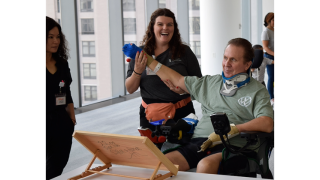Body
Chemodenervation is a treatment for spasticity that involves injections into tight muscle. This treatment is used when spasticity is severe, in specific locations, or is interfering with specific movements. It may include one or more injections of medicine into the affected muscles. Four botulinum toxins (Botox,® Myobloc,® Dysport,® and Xeomin®) are currently available for chemodenervation. These medications are also known by the following generic names: onabotulinumtoxinA, rimabotulinumtoxinB, abobotulinumtoxinA and incobotulinumtoxinA, respectively.
What is botulinum toxin?
Botulinum toxin is produced by the bacteria, Clostridium botulinum. This toxin causes muscle weakness and when injected in tiny amounts into muscle, makes the muscles relax. This occurs because the botulinum toxin blocks the nerve from releasing a chemical substance in the body, called acetylcholine, which normally signals the muscle to tighten.
What kinds of medical conditions may be helped by botulinum toxin?
This group of drugs has been used for many causes of spasticity, including as the result of:
• stroke
• multiple sclerosis
• spinal cord injury
• traumatic brain injury
• cerebral palsy.
The Food and Drug Administration (FDA) has approved Botox, Dysport, and Xeomin for the treatment of upper limb spasticity in adults, specifically spasticity at the elbow, wrist and fingers. Botox and Dysport have been approved for treatment of distal (lower) leg muscles in adults and both have been also approved for the treatment of spasticity in the arm and legs in children 2 to 17 years old, although these FDA approvals exclude spasticity treatment for children with cerebral palsy in the arm for Dysport and for the leg for Botox. The FDA has not approved the other botulinum toxins for the treatment of spasticity in the legs, for the treatment of spastic muscles at the shoulder or thigh, nor has it approved the specific drugs explained above for the treatment of spasticity of the arms versus legs in children with cerebral palsy; however, they are commonly used this way clinically. This is termed “off-label” use.
Injections of the botulinum toxins may also be used in treating involuntary continuous tightening or twisting of the neck or limbs, a condition called cervical dystonia or limb dystonia. The FDA has approved the four botulinum toxins listed above for the treatment of cervical (neck) dystonia.
How soon do the injections work and how long do they last?
Gradual relaxation of the muscles begins one to three days after the injection. Effects are strongest at about two to four weeks and wear off in about three to six months. This means that the treatment may need to be repeated, sometimes as often as every three months, if there are functional problems or pain when the tightness returns.
How is the medicine given?
The botulinum toxins are injected directly into the muscles that are tight. If more than one muscle is tight, then more than one injection is given. Larger muscles may require more than one injection site. In order for the physician to locate the correct place to inject, an EMG machine may be used to record the electrical activity of the muscle. Sometimes stimulation of the nerves or ultrasound (sound waves) are used to locate the correct muscle.
Does botulinum toxin interfere with other medicines?
Botulinum toxins do not generally interfere with other medicines, but some issues to consider are:
• Those taking medicine for myasthenia gravis should not undergo chemodenervation injections.
• Individuals taking blood thinning medication (Coumadin®/warfarin), must have regular blood tests reviewed. It is helpful for patients to bring these results to each appointment.
• Other medications, including Aspirin, that are taken to prevent blood from clotting or medications used for arthritis pain, like Ibuprofen, can increase the risk of bleeding in the area of injection.
What are the most common side effects of injections with botulinum toxin?
• The most common side effects are pain, soreness, stiffness, slight redness or swelling at the injection site or the limb.
• Mild swallowing problems sometimes occur if injections are given in the neck.
• People taking medicine to prevent strokes, such as aspirin, or medicines that affect blood clotting are more likely to have bruising or bleeding from the injections.
• Myobloc may burn while being injected.
• Myobloc and to a lesser extent the other botulinum toxins may cause dryness in the mouth.
Patients that use their limb tightness to help with functioning (such as wedging items in between the tight fingers or carrying items on the limb that is flexed (bent up) at the elbow, may notice more difficulty with this action. You should tell your doctor if you use your tightness this way.
Are there other side effects?
A number of other side effects have been reported but are very rare. These include:
• Headache
• Seizures have been reported in stroke patients, but not any more often than in those stroke patients not receiving the injections.
• Flu-like muscle aches.
These other, very rare side effects are also possible. Anyone experiencing any of the following should contact their doctor immediately:
• Swallowing problems following neck injection, if they occur, are generally mild, but sometimes patients have to change their diet for a while or have a feeding tube. Swallowing problems have rarely been reported with limb injections, and can also lead to serious pneumonia.
• Blood clot (hematoma) large enough to require surgery to relieve pressure in a limb area, has been reported very rarely, or infection at the injection site may also occur very rarely.
• Generalized muscle weakness including swallowing problems, and incontinence of urine can happen, from injections in the limbs. This may also include difficulty talking or breathing. This usually only has been seen if very large doses are used, or if used in higher doses in patients with underlying breathing problems.
• Rash
• Eye problems including drooping lids, double vision and blurred vision
• Constipation
References:
Early Communication about an Ongoing Safety Review Botox and Botox Cosmetic (Botulinium toxin Type A) and Myobloc (Botulinum toxin Type B). US Food and Drug Administration Center for Drug Evaluation and Research. February, 2008.
http://yourcpf.org/treatments/
https://www.ninds.nih.gov/Disorders/All-Disorders/Spasticity-Information-page
This content is for informational purposes only and may not be comprehensive. Information contained does not imply an endorsement from Shirley Ryan AbilityLab, and does not replace the advice of a qualified healthcare professional. See here for further details. © Shirley Ryan AbilityLab (formerly Rehabilitation Institute of Chicago). Henry B. Betts LIFE Center – (312) 238-5433 – https://www.sralab.org/lifecenter.
Body



